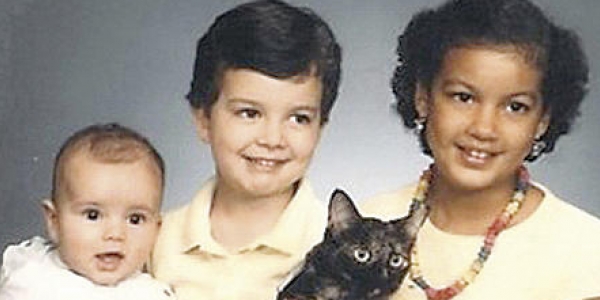The Chronicle Review
The Chronicle of Higher Education
2015-07-06
Sarah Valentine, Visiting Assistant Professor of English
Northwestern University, Evanston, Illinois

Sarah Valentine as a girl, with her two brothers (Source: Family photo)
Rachel Dolezal’s recent unmasking as a white woman living as black sparked a debate about the legitimacy of “transracial” experience. I cannot speak for Dolezal or anyone else, but I can state for a fact that racial transition is a valid experience, because I have gone through it.
While most people would look at this photo and see a black girl, two white boys, and a very surprised cat, they would be wrong. The girl in the photo is white, just like her brothers. I was raised in a white family from birth and taught to identify as white. For most of my life, I didn’t know that my biological father was black. Whenever I asked as a child about my darker skin, my mother corrected me, saying it was not dark but “olive.” When others asked if I was adopted, my mother ignored them. Eventually everyone, including me, stopped asking.
When, as an adult, I learned the truth of my paternity, I began the difficult process of changing my identity from white to black. The difficulty did not lie in an unwillingness to give up my whiteness. On the contrary, the revelation of my paternity was a relief: It confirmed that I was different from my parents and siblings, something I had felt deeply all my life.
The dilemma I faced was this: If I am mixed race and black, what do I do with the white sense of self I lived with for 27 years, and how does one become black? Is that even possible? Now, you may say that the rest of the world already saw me as black and all I had to do was catch up. True. But “catching up” meant that I had to blow the lid off the Pandora’s box of everything I thought I knew about myself and about race in America…
Read the entire article here.